Modern Slavery: National Referral Mechanism and Duty to Notify Statistics UK, Quarter 4 2020 – October to December
Updated 18 March 2021
Frequency of release: Quarterly
Forthcoming release: Home Office statistics release calendar
Home Office responsible statistician: Daniel Shaw, Chief Statistician
Press enquires: pressoffice@homeoffice.gov.uk
Telephone: 020 7035 3535
Public enquires: NRMStatistics@homeoffice.gov.uk
This statistical bulletin provides a summary and breakdown of the number of potential victims of modern slavery referred into the National Referral Mechanism (NRM) or via the Duty to Notify (DtN) process from 1 October to 31 December 2020 (quarter 4). Please also refer to the data tables published alongside this bulletin for further data.
Key results
In quarter 4 2020, 3,042 potential victims of modern slavery were referred to the NRM; a 22% increase from the preceding quarter, but a 9% decrease from quarter 4 in 2019.
Of these, 57% (1,732) claimed exploitation in the UK only, whilst 34% (1,029) claimed the exploitation took place overseas only.
Half (50%) of the referrals were for individuals claiming exploitation as adults, with the remainder claiming exploitation as children (43%) or their age at exploitation was unknown (6%).
For adult potential victims, labour exploitation was most frequently reported, whereas criminal exploitation was most common for child potential victims.
Potential victims from the UK, Albania and Sudan were the three most common nationalities referred.
The Single Competent Authority made 3,020 reasonable grounds and 986 conclusive grounds decisions in this quarter. Of these, 93% (2,797) of reasonable grounds and 90% (883) of conclusive grounds decisions were positive.
During this quarter, the DtN process referred 663 adults to the Home Office.
Number of quarterly NRM referrals from 2014 to 2020

1. Introduction
Modern slavery is a term that includes any form of human trafficking, slavery, servitude or forced labour, as set out in the Modern Slavery Act 2015. Potential victims of modern slavery in the UK that come to the attention of authorised First Responder Organisations may be referred to the National Referral Mechanism (NRM). Authorised First Responder Organisations include local authorities, specified non-governmental organisations (NGOs), police forces and specified government agencies.
The NRM is the UK’s framework for identifying and supporting victims of modern slavery, details of which are set out in: Modern Slavery: Statutory Guidance for England and Wales (under s49 of the Modern Slavery Act 2015) and Non-Statutory Guidance for Scotland and Northern Ireland.
Adults (aged 18 or above) must consent to their referral to the NRM, whilst children under the age of 18 need not consent. First Responder Organisations can also refer adults who were exploited as children. As specified in section 52 of the Modern Slavery Act 2015, public authorities in England and Wales have a statutory duty to notify the Home Office when they come across potential victims of modern slavery. This duty is discharged by either referring a child or consenting adult potential victim into the NRM, or by notifying the Home Office if an adult victim does not consent to enter the NRM.
When referred to the NRM, the Single Competent Authority (SCA) within the Home Office makes a ‘reasonable grounds’ decision on whether an individual could be a victim of modern slavery.
Adults given a positive reasonable grounds decision have access to support (including accommodation, subsistence, legal aid and counselling) pending a ‘conclusive grounds’ decision on their case. Local authorities support children.
Adults receiving a positive conclusive grounds decision are currently entitled to at least a further 45 days of support to allow them to ‘move on’ from NRM support, whilst those with a negative decision receive 9 days of support. See further information regarding the NRM process.
1.1 User feedback survey
The user feedback survey on NRM statistics ran for 6 weeks and closed on 1 May 2020. We received 50 responses from a range of stakeholders and would like to thank those who responded. We have made some suggested changes and will consider further changes to future bulletins, which we will highlight in each of the releases.
Please email NRMStatistics@homeoffice.gov.uk if you have any further comments or questions regarding these statistics.
2. National Referral Mechanism (referrals)
2.1 Number of referrals by age group
In the fourth quarter (Q4) of 2020, the NRM received 3,042 referrals of potential victims of modern slavery. This represents a 22% increase in referrals compared to the preceding quarter (2,500) and a 9% decrease from Q4 in 2019 (3,344). This is the second quarter-on-quarter increase in the number of referrals since the beginning of the COVID-19 pandemic (data table 1), driven primarily by an increase in the number of referrals for adult potential victims and referrals for those potentially exploited overseas.
In this quarter, referrals for both adult and child potential victims have increased compared to the preceding quarter (Figure 1). Half (50%; 1,532) of the NRM referrals were for adult potential victims (similar to the preceding quarter), whilst 43% (1,321) claimed exploitation as children (Figure 1). The age group at exploitation was unknown in 6% of cases (189).
Figure 1: Number of quarterly NRM referrals by age group of exploitation, 2014 to 2020
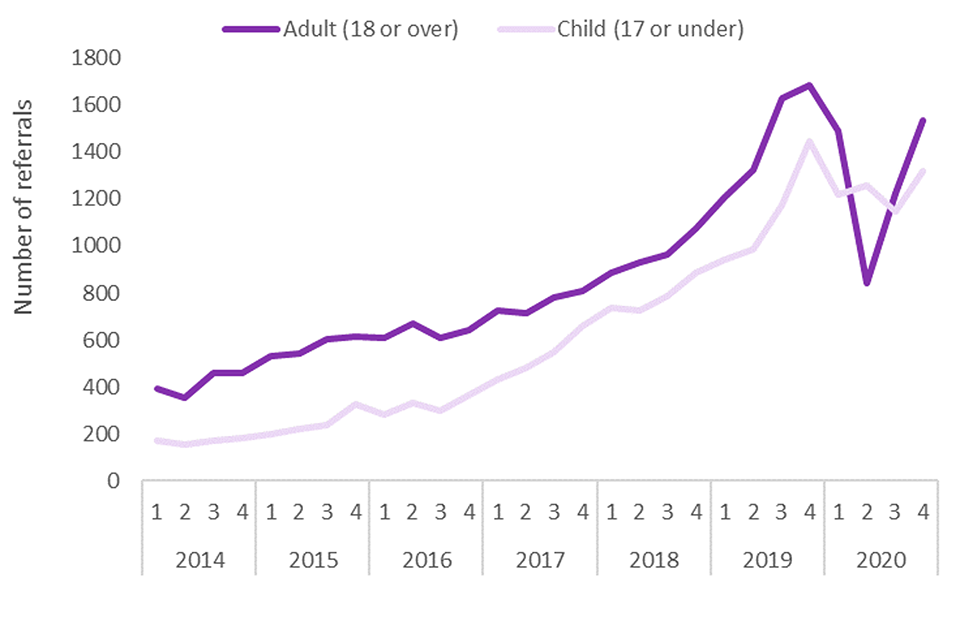
Source: SCA
Notes: Excludes data pre-2014 due to data reliability. Excludes referrals where the age group at exploitation is unknown.
2.2 Location of exploitation
Overall, 57% (1,732) of potential victims claimed exploitation in the UK only, compared to 64% in the last quarter, whilst 34% (1,029) claimed exploitation overseas only (data table 2 and Figure 2). Referrals of potential victims who claimed exploitation both in the UK and overseas (9%; 279) decreased slightly compared to the previous quarter.
Figure 2: Number of quarterly NRM referrals by location of exploitation, 2014 to 2020
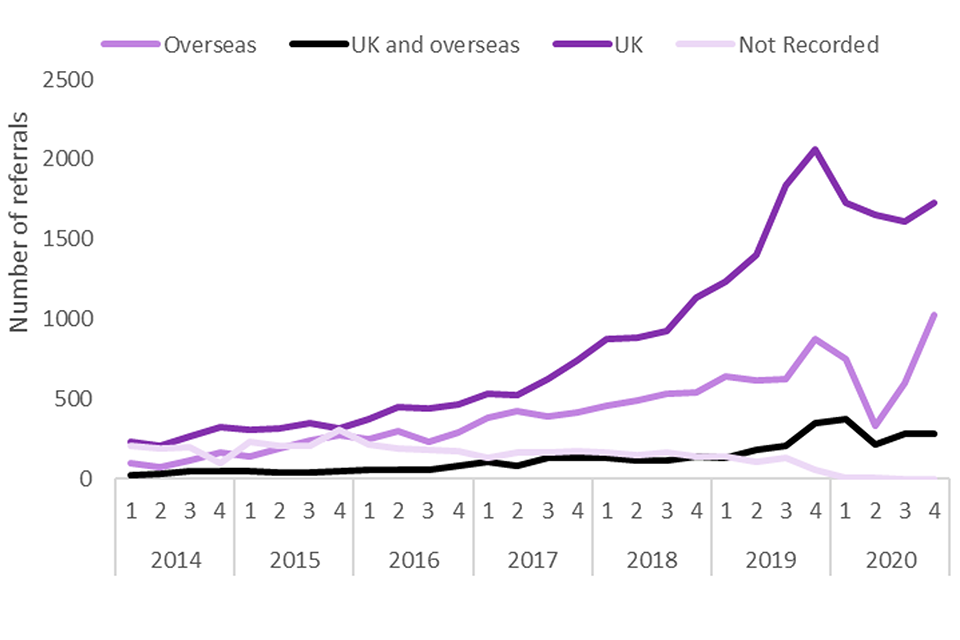
Source: SCA
Notes: Excludes data pre-2014 due to data reliability.
As in previous quarters, of those referrals for UK-based exploitation only, a higher proportion were child potential victims (59%; 1,028) than adults (37%; 640). A large proportion of the referrals for exploitation overseas only were adults (69%; 715) whilst 21% (214)were child potential victims.
2.3 Referrals by gender and exploitation type
Overall, of the 3,042 potential victims referred in this quarter, 77% (2,336) were male and 23% (700) were female; similar proportions to the previous quarter. For adult potential victims, 75% (1,148) were male and 25% (382) were female, whilst for child potential victims, 79% (1,037) were male and 21% (280) were female.
Figure 3: Number of NRM referrals for the most common exploitation types in Q4, by age group at exploitation
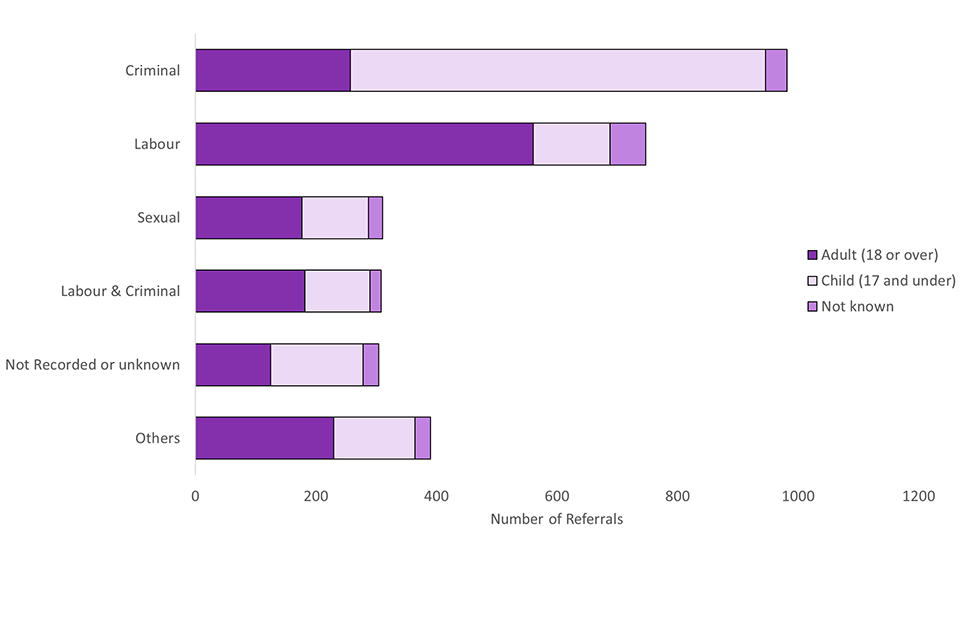
Overall, potential victims were most commonly referred for criminal exploitation only, which accounted for 32% (982) of all referrals (Figure 3). An additional 14% (419) of referrals were for potential victims referred for criminal exploitation combined with other exploitation types.
Labour exploitation was most commonly reported for adult potential victims (37%; 561) and most of those (92%; 515) were male. Criminal exploitation was most commonly reported for child potential victims (52%; 689), and the majority (91%; 628) of those were male. For both adult and child potential victims, most referrals for sexual exploitation (87% and 85% respectively) were for female potential victims. See further information on types of exploitation.
For those exploited as children, an increase in the identification of ‘county lines’ cases has partially driven the rise in the number of cases categorised within the ‘criminal exploitation’ category. County lines are used to describe drug gangs in large cities expanding their reach to small towns. Often, drug gangs exploit vulnerable individuals to transport substances, and mobile phone ‘lines’ are used to communicate drug orders. See further information on county lines.
In Q4, 503 referrals were flagged as county lines referrals, accounting for 17% of referrals (data table 27). The majority (79%; 395) of these referrals were for male children.
Figure 4: Number of NRM referrals flagged as county lines, by age group at exploitation and gender

Source: SCA
Notes: County lines referrals were classified as a sub-type of labour exploitation prior to Q4 2019. Since January 2020, a ‘flag’ within the NRM digital casework system identifies county lines referrals.
2.4 Referrals by nationality
As in previous quarters, the most common nationality referred were UK nationals, which accounted for 31% (958) of all potential victims (compared to 35% in Q3). The second most commonly referred nationality was Albanian (15%; 452). The majority (80%; 766) of referrals for UK nationals were for child potential victims, whilst for Albanian nationals, the majority (83%; 373) were for adult potential victims (Figure 5).
Sudanese nationals were the third most commonly referred in this quarter (8%; 230), overtaking Vietnamese nationals (5%; 162) for the first time. The increase in referrals for Sudanese nationals has been seen from government agencies (primarily Immigration Enforcement), but also local authorities and NGO or third-sector first responders.
Please note, a change to data recording from 1 October 2019 means that NRM data reflects the dual nationality of potential victims in separate categories. To see total counts of a particular nationality, please refer to the data tables. A potential victim’s nationality is based on information provided by the first responder upon referral, however case workers may update this as further information is gathered.
Figure 5: Number of NRM referrals for the most common nationalities of potential victims in Q4 2020, by age group at exploitation

Source: SCA
Notes: Excludes potential victims with an unknown age at exploitation. There are separate categories for dual-nationals.
2.5 Referrals by location of crime investigation
Upon receiving an NRM referral, the SCA determines the responsible geographic police force for investigation based on the information provided on the referral form and transfers the referral for investigation. Transfer between police forces can take place as further information is received, which is reflected in the statistics. Previously, British Transport Police referrals were classed under England, but have now been separated out in the data tables.
As in previous quarters, most (92%; 2,807) of the NRM referrals were sent to police forces in England; 3% (92) to Police Scotland, 3% (80) to Welsh police forces and 1% (31) to the Police Service of Northern Ireland (data table 2). Of all referrals, 29% (883) were sent to the Metropolitan Police Service, which is the same as the previous quarter (29%).
2.6 First responders
In Q4 2020, 37% (1,116) of the referrals came from government agencies, up from 27% in Q3 2020. Of these referrals, 49% (546) came from Home Office Immigration Enforcement, compared to 34% in the previous quarter, whilst a large proportion also came from UK Visas and Immigration (47%; 520) (Figure 6 and data table 9). Increased travel both into and out of the UK and increased interaction with Home Office agencies may have caused the increase in referrals from government agencies.
Figure 6: Number of NRM referrals by first responder types
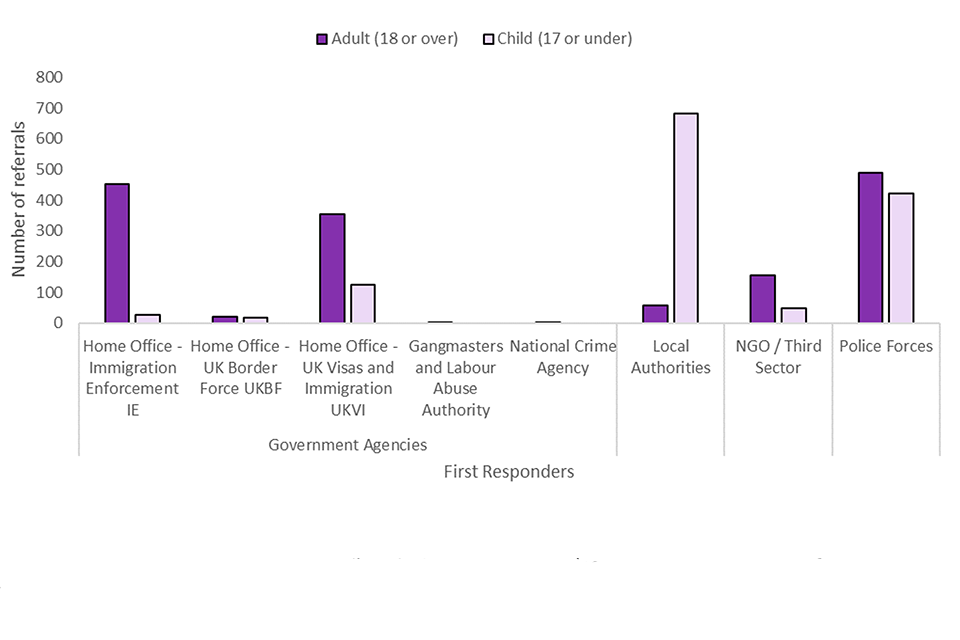
Source: SCA
Notes: Authorised First Responder organisations include local authorities, specified NGOs, police forces and specified government agencies. Excludes potential victims with an unknown age at exploitation.
Police forces accounted for 31% (945) of NRM referrals in Q4 (similar to the 34% seen in Q3). NGO / third-sector organisations accounted for 7% (214) of referrals. Local authorities accounted for 25% (767) of referrals (down from 29% Q3), and most of these were for child potential victims (Figure 6 and data table 9).
3. National Referral Mechanism (decisions)
3.1 Reasonable grounds decisions
The SCA made 3,020 reasonable grounds decisions in Q4 2020. It is important to note that some of these decisions were made on referrals received in previous quarters. Of these decisions, 93% (2,797) were positive and 7% (233) were negative, similarly 93% were positive in Q3. The proportion of positive reasonable grounds decisions was higher for child potential victims (96%; 1,245) than adults (90%; 1,388) (data table 28).
Figure 7: Number of NRM positive and negative reasonable grounds decisions

Source: SCA
Notes: Based on the quarter and or year that the decision was made.
3.2 Conclusive grounds decisions
In Q4, the SCA made 986 conclusive grounds decisions, an increase from 919 made in the preceding quarter. It is important to note that the decisions made by the SCA in this quarter will include decisions on referrals made in previous years. Of the decisions made this quarter, 90% (883) were positive and 10% (103) were negative. The proportion of positive conclusive grounds decisions was higher for child potential victims (95%; 408) than adults (85%; 449) (data table 29).
Figure 8: Number of NRM positive and negative conclusive grounds decisions
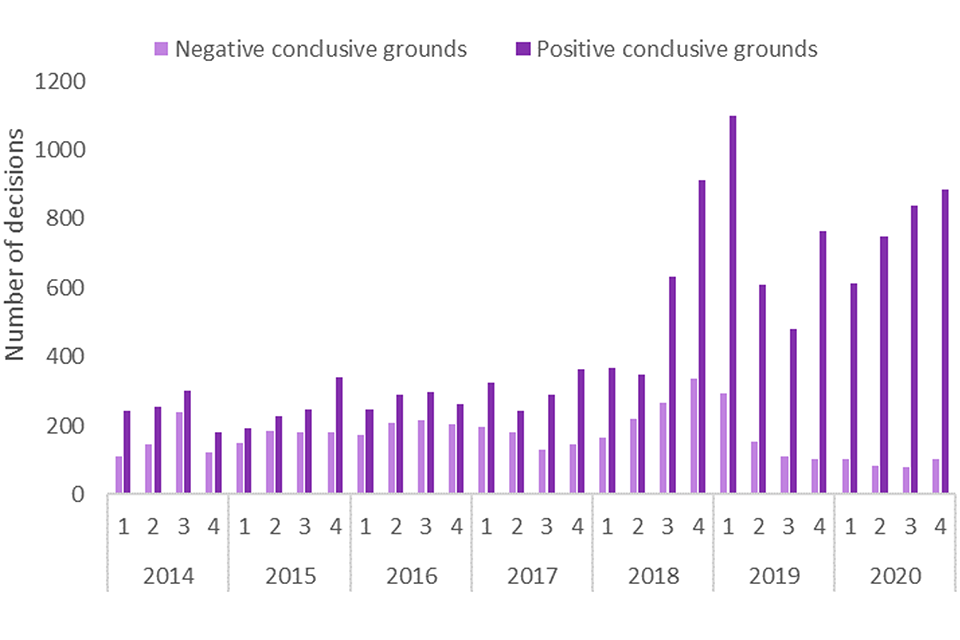
Source: SCA
Notes: Based on the quarter and or year that the decision was made.
The average (median) time taken from referral to conclusive grounds decisions made in this quarter was 430 days, which is higher than the 344 days in Q3. It is important to note that the decision-making times presented here are for cases that received a conclusive grounds decision from the SCA in this period and do not reflect the waiting time of all cases within the system. Some cases that receive decisions in this period may have taken longer to reach a decision than those in previous quarters (data table 30).
4. Duty to Notify
Since 1 November 2015, specified public authorities in England and Wales must notify the Home Office via the Duty to Notify (DtN) process of suspected adult victims of modern slavery that do not consent to enter the NRM. During this process, first responders do not collect the potential victim’s personal details.
In Q4, the Home Office received 663 reports of adult potential victims via the DtN process (Figure 9), compared to 485 in Q3. Of these:
- as in Q3, the most referred nationalities were Albanian (19%; 128), UK (12%; 78)and Romanian (11%; 76) (data table 32)
- the most referred exploitation types were labour (34%; 228), sexual (20%; 134) andcriminal exploitation (16%; 106) (data table 33)
- in terms of first responders, most DtN reports were submitted either by governmentagencies (57%; 380) or the police (37%; 246)
Figure 9: Number of Duty to Notify referrals
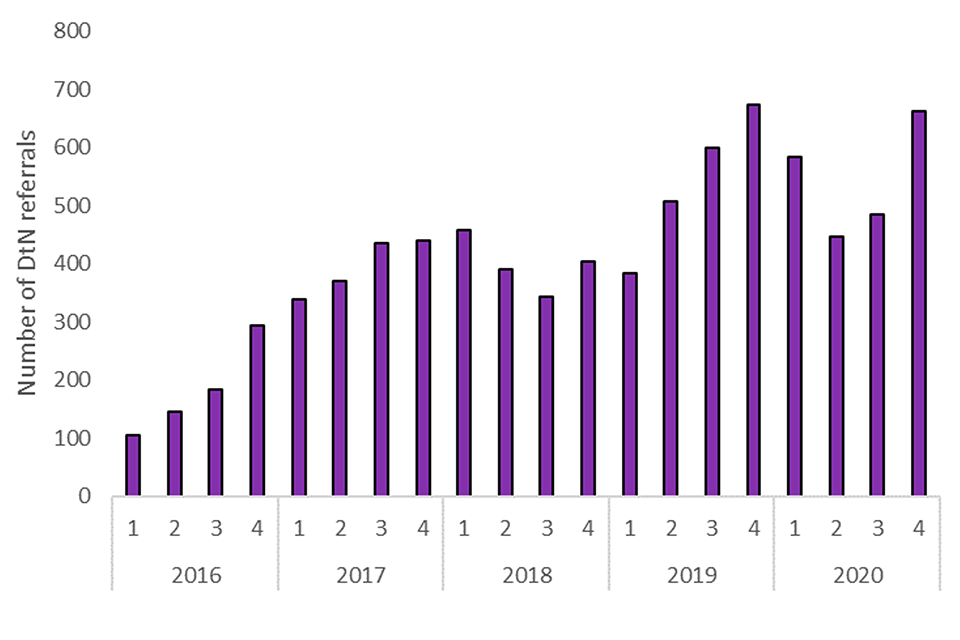
Source: SCA
Notes: Potential victims may be reported via DtN and subsequently also be referred to the NRM at a later point in time, so these figures should not be combined due to potential double counting.
5. Further information
5.1 Quality information
All percentages are rounded to the nearest whole percentage point.
It is important to note that the statistics presented in this publication relate to the number of potential victims of modern slavery referred to the NRM or via the DtN process.
These statistics are based on the situation as at 1 February 2021 when an extract was taken from the live management information system. The figures may differ from previous or future reports as new information comes to light and cases update accordingly.
NRM statistics were previously published by the National Crime Agency (NCA) prior to transfer of NRM decision-making responsibilities to SCA in April 2019 as part of the NRM Reform Programme. Publications prior to July 2019 can be accessed via the NCA website. With this transfer of responsibility, these data are now designated as official statistics and produced in line with the Code of Practice for Statistics.
Data tables for further analysis are online alongside this bulletin.
This statistical bulletin is produced to the highest professional standards and is free from political interference. It has been produced by statisticians working in the Home Office Analysis & Insight Directorate in accordance with the Home Office’s Statement of compliance with the Code of Practice for Official Statistics, which covers Home Office policy on revisions and other matters. The Chief Statistician, as Head of Profession, reports to the National Statistician with regarding all professional statistical matters and oversees all Home Office National Statistics products regarding the Code, being responsible for their timing, content and methodology.
Changes to recording of exploitation type
Prior to 1 October 2019, potential victims of modern slavery were recorded as having a single primary exploitation type, grouped into five distinct categories: labour, sexual, domestic servitude, organ harvesting or unknown exploitation. Following changes to the way NRM data are collected, recording of exploitation types has changed to give a better picture of the exploitation experienced by potential victims. As a result, for referrals received from 1 October 2019, criminal exploitation is separate to labour exploitation. In addition, potential victims can also be recorded as experiencing multiple exploitation types, so apply caution when comparing exploitation type statistics from Q4 2019 with previous quarters, as the primary exploitation type is unknown. Furthermore, ‘Unknown exploitation’ is no longer a distinct category on the online form that first responders use when submitting a referral; instead, data for unclassified exploitation can be provided in a free text box field. For statistical reporting, this field is grouped as ‘Not specified or unknown’.
Police force data provided in associated reference tables are based on the location of the police force that received the NRM referral. Each referral is screened against the criteria below to identify the responsible geographic police force. Once identified, the referral is transferred for action to the relevant Force Intelligence Bureau or stipulated point of receipt within the force. Sometimes, further information is received and processed regarding a referral, which means it will be sent to a different police force. This will be reflected in the updated statistics. Criteria applied to identify the relevant police force:
- the force has acted as first responder, or the referral indicates that the force isalready involved in the recording/investigation of the potential modern slavery humantrafficking offences
- the potential victim has been exploited within the force area
- the potential victim has been exploited abroad, or at an unknown location and thevictim’s address at time of referral is within the force area
- the potential victim has been exploited abroad or at an unknown location and theyhave presented to another first responder within the force area
5.2 Other related publications
National Referral Mechanism Statistics Quarter 2 2019 – April to June
National Referral Mechanism Statistics Quarter 3 2019 – July to September
National Referral Mechanism Statistics Quarter 4 2019 – October to December
National Referral Mechanism Statistics UK, End of Year Summary, 2019
National Referral Mechanism Statistics UK, Quarter 1 2020 – January to March
Modern Slavery: National Referral Mechanism and Duty to Notify Statistics UK, Quarter 2 2020 – April to June
Modern Slavery: National Referral Mechanism and Duty to Notify Statistics UK, Quarter 3 2020 – July to September
Modern Slavery: National Referral Mechanism and Duty to Notify Statistics UK, End of Year Summary, 2020
Feedback and enquiries
We are always looking to improve the accessibility of our documents. If you find any problems, or have any feedback, relating to accessibility, or general questions regarding this publication, please email us NRMStatistics@homeoffice.gov.uk.
